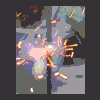Posted 23 November 2009 - 05:26 PM
The small back street chinese work shops make there cardboard hemisphers with pre-cut & patterned round discs of brown paper + paste in a few layers. which is compressed via a spinning half-moon shape drill tool come hydraulic pressing machine into a former, the same machine then trims/cuts the edges in one go,...there is a film of it on youtube somewhere.
The large commercial cone making equipment is numerous & huge,(paper mill scale),..will have to search for this another time.
For those who have adapted there 10 tonne hydraulic garage presses at home to press comps, cone shape tooling will have to made or bought,....although the spinning action is not needed (infact it would make it difficult), as was mentioned elsewhere, the cone shape paper is made by cutting a wedge in a circle, then taped in place and layered & pasted as above.
To help increase the strength of the base of the cone, a 3 or 4 prong protruding square edge from a circle of ply could be used (its like a circle with a few outside square edges) , this then slots & twists into a `L` shape cut into the casing of the base of the cone, the gap is packed with glue/sawdust or plaster (might be possible to use cone again)
Damn,..I wished I had bought that benchtop plastic moulding machine that was on Ebay a few week ago for £120.
















